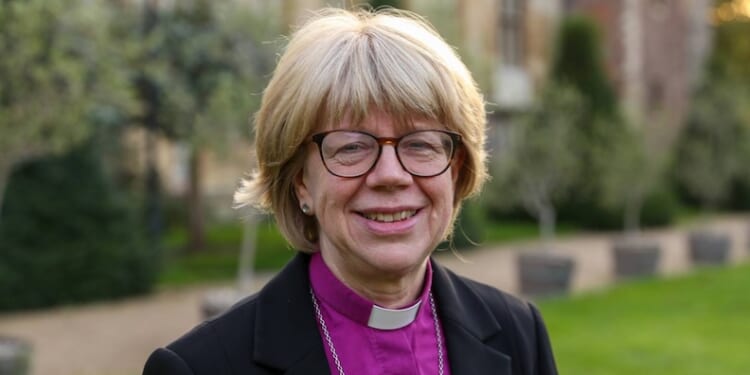The announcement of the appointment of Sarah Mullally as the 106th Archbishop of Canterbury marks a historic first for the Church of England (CoE), which traces its origins back more than 1,400 years to the time of Saint Augustine of Canterbury. In addition to being the head of the CoE, the Archbishop of Canterbury also serves as the spiritual leader of the world-wide Anglican Communion, whose thriving churches of the Global South have become increasingly alienated from the mother church due to the latter’s long-term drift toward theological liberalism. This appointment will surely widen that breach.
Already in the 1940s proposals were circulating in the CoE in support of the ordination of women priests. Those early efforts provided the impetus for a 1948 essay by the well-known Anglican writer, C.S. Lewis. The arguments he lays out in “Priestesses in the Church?” are worth revisiting and seem as relevant today as when he first penned them – and for Catholics as well as Anglicans.
As Lewis makes clear at the outset, his opposition to women’s ordination is not based on the claim that women are any less capable than men with respect to the many qualifications associated with priestly ministry: “No one among those who dislike the proposal [for the ordination of women priests] is maintaining that women are less capable than men of piety, zeal, learning and whatever else seems necessary for the pastoral office. . . .[Women] may be as ‘God-like’ as a man, and a given woman much more so than a given man.”
Lewis further asserts that the Church’s historical opposition to the practice of female ordination could not possibly have been rooted in a contempt for women’s religious capacities. And that, for one simple reason. As he writes, “the Middle Ages carried their reverence for one Woman to a point at which the charge could be plausibly made that the Blessed Virgin became in their eyes almost ‘a fourth Person of the Trinity.” Despite this, Lewis continues, never “in all those ages was anything resembling a sacerdotal office attributed to her.”
Lewis lays out four arguments for his opposition. The first concerns the nature of the priestly office. In the more traditional understanding, the priest is seen primarily as a representative; in fact, he is a “double representative, who represents us to God and God to us.” The latter function, in which the priest represents God to us, is something that only a man can perform: “Only one wearing the masculine uniform can (provisionally, and till the Parousia) represent the Lord to the Church: for we are all, corporately and individually, feminine to him.”
His second argument revolves around the authority of the Church. The practice of only ordaining men to the priesthood is something the Church has done as the bearer of divine revelation, as the guardian of the depositum fidei. If this claim for the Church’s authority is false, Lewis contends, “then we want not to make priestesses but to abolish priests.” For then the Church would have no authority to ordain anyone.

Lewis’ third argument centers on the fact that the Church’s imagery and language reflect the proper order of things. The Church affirms, for example, that in the Eucharistic celebration the priest stands in persona Christi, in the person of Christ. But the second person of the Trinity is called the Son, not the Daughter. And the mystical marriage is between Christ the Bridegroom and the Church as his Bride; a reversal of these roles is simply unthinkable. Moreover, in the Lord’s Prayer, we address ourselves to “Our Father,” not to “Our Mother.”
For Lewis, this language carries great weight. Turning the male language into a feminine gender (or, by extension, into some gender-neutral variation) does violence to our understanding of God. Goddesses were worshipped in other religions, but not in Christianity, he points out. So, to feminize the godhead (or to neuter it) is to embark on a different religion. God Himself, Lewis pointedly observes, “has taught us how to speak of Him.”
The imagery matters, and to claim that it doesn’t “is to say either that all the masculine imagery is not inspired, is merely human in origin, or else that, though inspired, it is quite arbitrary and unessential.” This is intolerable, “or, if tolerable, it is an argument not in favor of Christian priestesses but against Christianity.”
Finally, Lewis considered the push for women’s ordination to be based on a basic anthropological misunderstanding – even more common in our time than in his – that regards sex as “something superficial, irrelevant to the spiritual life.” No longer seen as an organic unity of human body and human soul, men and women are now understood to be homogeneous, interchangeable parts rather than “different and complementary organs of a mystical body.”
As Lewis poignantly writes, “We have no authority to take the living and semitive [seminally signifying] figures which God has painted on the canvas of our nature and shift them about as if they were merely geometrical figures.”
Lewis concludes by drawing an interesting, if somewhat fanciful, parallel between the Church and a Ball. Unlike the factory or a political party, he observes, “the Ball exists to stylize something which is natural and which concerns human beings in their entirety – namely, courtship.” We cannot tamper with that arrangement without undermining its purpose, he avers.
This applies with even greater force to the Church, “for there we are dealing with male and female not merely as facts of nature but as the live and awful shadows of realities utterly beyond our control and largely beyond our direct knowledge. Or rather, we are not dealing with them but (as we shall soon learn if we meddle) they are dealing with us.”
In the various confusions of contemporary gender ideology, we are reaping the bitter fruit of the “meddling” against which Lewis so prophetically warned.




![Hegseth Demands Fitness Requirements, Says 'Fat Troops' 'Not Who We Are' [WATCH]](https://teamredvictory.com/wp-content/uploads/2025/09/Hegseth-Demands-Fitness-Requirements-Says-Fat-Troops-Not-Who-We-350x250.jpg)






